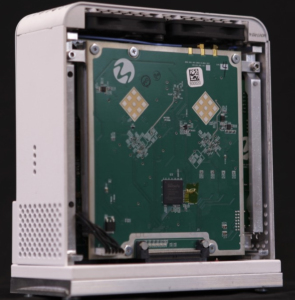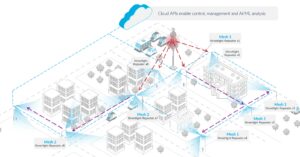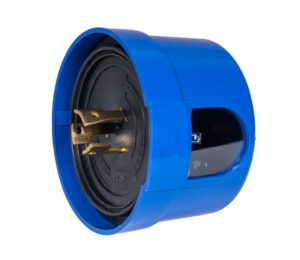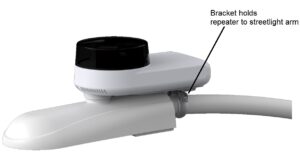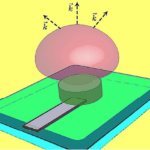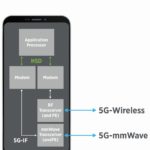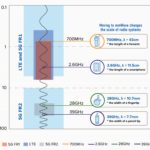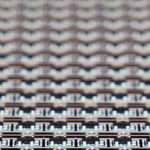Wireless infrastructure company Ubiquia puts mmWave repeaters on tor of streetlights, which can bring high-speed connectivity to urban areas and town centers.
For years, we’ve been hearing that mmWave’s wide bandwidth is what truly sets 5G apart from previous wireless technologies. We’ve also heard about its short range and need for line-of-sight transmissions. That short range creates an installation problem because mmWave needs many more cells that needed at lower frequencies. The cost of installing small cells on utility poles, streetlights, and just about any other place makes mmWave rather expensive. As a result, the business press continues to question the value of mmWave.
Engineers being engineers often find workarounds to such problems. Recently, Florida-based Ubicquia and California-based Movandi have teamed up to address a possible solution to the mmWave deployment problem: Install mmWave repeaters on streetlights. 5G Technology World spoke with Ubicquia’s Jeorg Lehnich and Movandi’s Craig Ochikuba about the engineering issues involved with creating a product to inexpensively bring mmWave to the masses.
“mmWave has a range of about 250 m and even trees can attenuate the signals,” said Lehnich. “You need ten times more sites than you need with macro base stations. Acquiring a site to build a small tower in a city is difficult and takes years. Permitting takes 12 to 18 months. Construction takes a year. Installing on light poles cuts the time and cost. The world has some 360 million potential sites with 65 million in U.S. alone. We expect that number to increase to 72 million to 75 million streetlights by 2025.”
Another issue with bringing mmWave to the masses is that small cells must connect to a 5G network through a wired or microwave backhaul connection. Instead, Ubicquis uses the components in Movandi’s BeamXR mmWave repeaters (Figure 1) to extend the range of a carrier’s mmWave signal from a nearby gNodeB.
Figure 2. Ubicquia’s 5G repeaters with Movandy hardware can connect mesh network with up to four hops from a single gNodeB. Image: Ubicquia/Movandi
According to Ochikuba, the BeamXR uses Movandi’s RFIC chipsets and antennas developed in house. The 3GPP-compliant device takes signals from base stations, redirects them and amplifies them downstream (Figure 2). It can steer the signal around corners. It can mesh and daisy chain up to four “hops” to extend range, all transparent to the user. “We replicate the syncing and intelligence of the network,” said Ochikuba. “The BeamXR continually monitors its connection the base station. We provide telemetry to the cloud.”
The BeamXR uses multiple relay antennas with a single donor antenna. It produces three steerable beams to the users with one beam for the gNodeB. “We added smarts to connect to the cloud, said Ochikuba. “We automatically decide where to point the beams. Alternatively, we can direct the beam up to a building, depending on what the carrier wants.”
Because the repeaters connect directly or indirectly to a gNodeB, they supports just one carrier. “Carriers always want to own the equipment for best service quality,” said Lehnich. “Streetlights are roughly every 50 m apart so there are plenty of them if more than one carrier wants to use the Ubicquia streetlight repeater in a given geographic area.”
Because the repeater is not a small cell, it doesn’t need a fronthaul or backhaul connection to a network. Thus, it just needs AC power, which is available at the pole. Each pole has a light sensor on top, which uses a standard power connection that also holds it to the light fixture (Figure 3).
Lehnich explained that the arms of the streetlights were built to handle the weight of heavy fixtures for sodium bulbs. The conversion to LED lighting reduced weight and cut 70% of the electrical power previously needed. The cables were made to handle the higher current of those sodium bulbs. As a result, there’s plenty of capacity to add the repeater to the pole.
According to Lehnich, the AC power available to the pole ranges from 90 V to 500 V and can be quite “dirty.” The repeater design includes an internal power supply to convert to clean DC power for the internal BeamXR. In addition, the repeater contains a power monitor so the streetlamp owner — usually a municipality — can monitor the power consumed by each pole.
A repeater installs by simply locking it in to the socket. “We can install in 15 seconds,” said Lehnich. To help with wind issues, Ubicquia adds a bracket the installs around the arm for additional support (Figure 4).
“Instead of needing 900 gNodeBs,” said Lehnich, “operators can use 100 gNodeBs and 800 repeaters. That’s a huge cost savings.”

